San Ildefonso Miniature Black Carved Canteen by Rocky Martinez - C3903F
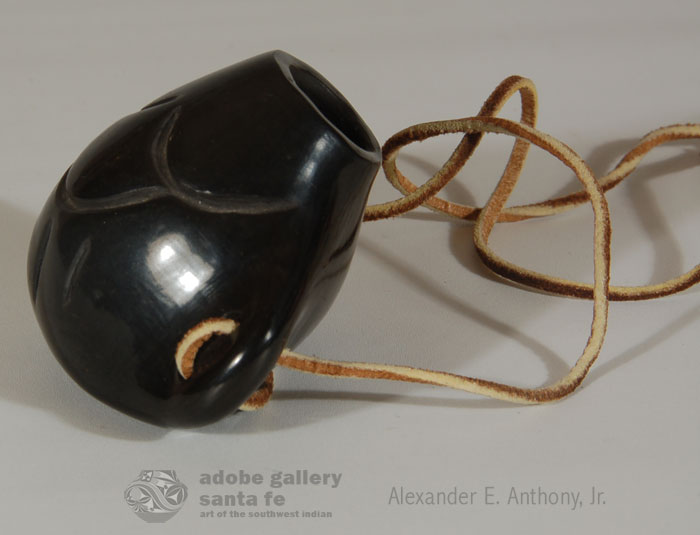 We tend to think that all San Ildefonso pottery is either plain black or black-on-black and that all Santa Clara pottery is black carved. Generally, that is the case, however, there are always exceptions to the rule to enlighten us.
We tend to think that all San Ildefonso pottery is either plain black or black-on-black and that all Santa Clara pottery is black carved. Generally, that is the case, however, there are always exceptions to the rule to enlighten us.
This miniature black canteen has a carved design of clouds and rain. It is signed with the name Rocky Martinez, a name I was unable to locate in any of my references, but I inquired of Elvis Torres of San Ildefonso to see if he could provide information on the family of Rocky Martinez so that we could place him accurately in our data. Elvis consulted with Adelphia Martinez (1935-present), daughter of Juanita and Wo-peen Gonzales, who told him that Rocky would sometimes make pottery with his grandmother, Juanita Wo-peen.
Would you like to buy or read more about this pottery?
Zuni Pueblo Small Polychrome Canteen - C3903H
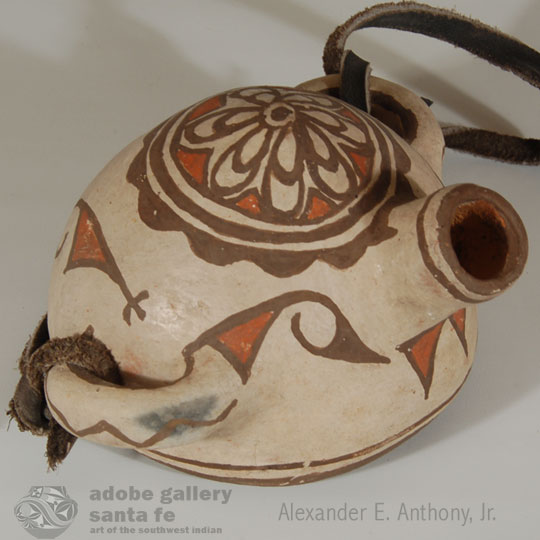 The primary design on this canteen is a rosette, located on top center of the body. This rosette is the same design used on most Zuni Pueblo Polychrome jars. Presumably, it is a design influence from the medallions seen on Spanish men's clothing. The other designs surrounding the medallion on this canteen are designs seen frequently on the neck of Zuni water jars. The potter used designs with which she was familiar.
The primary design on this canteen is a rosette, located on top center of the body. This rosette is the same design used on most Zuni Pueblo Polychrome jars. Presumably, it is a design influence from the medallions seen on Spanish men's clothing. The other designs surrounding the medallion on this canteen are designs seen frequently on the neck of Zuni water jars. The potter used designs with which she was familiar.
Original Oil Painting "Northern New Mexico Aspens" by Carl Von Hassler - 20516
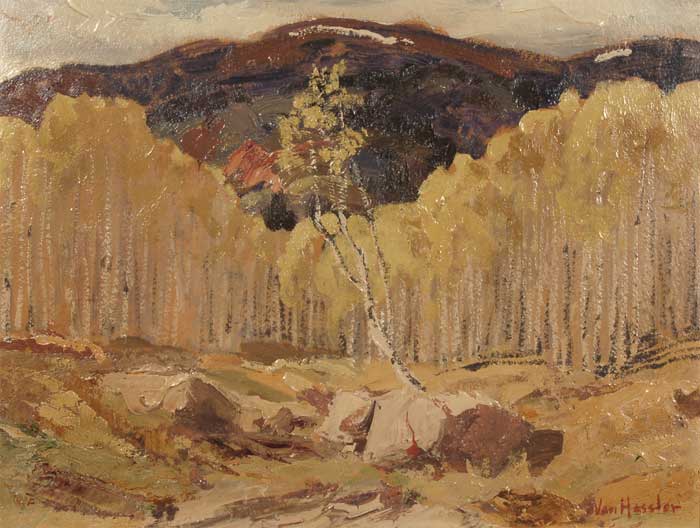 This is an oil painting executed in the Sangre de Cristo Mountains north of Santa Fe near the Tesuque River. Von Hassler often painted on site in areas in Northern New Mexico. He particularly liked the small Northern villages between Santa Fe and Taos.
This is an oil painting executed in the Sangre de Cristo Mountains north of Santa Fe near the Tesuque River. Von Hassler often painted on site in areas in Northern New Mexico. He particularly liked the small Northern villages between Santa Fe and Taos.
In his early years in Albuquerque, Von Hassler's studio was in the original Casa de Armijo (now La Placita Restaurant) in Old Town Albuquerque. He is best known for his traditional realistic landscapes of New Mexico and his Indian portraits.
Would you like to buy or read more about this painting?
Navajo Sterling Silver and Turquoise Ring with New Moon Shaped Stone - 24864
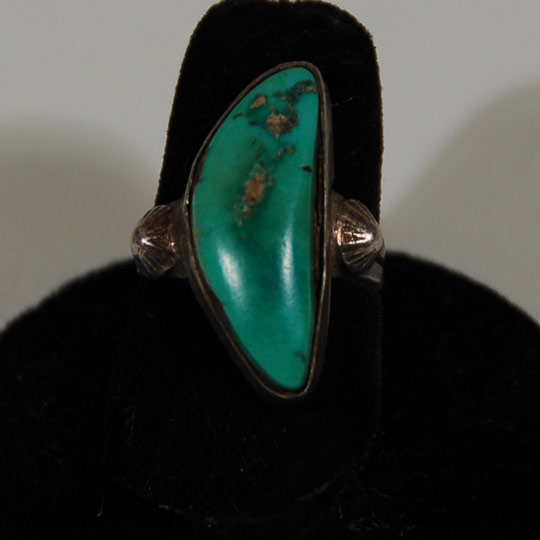 This beautiful green turquoise stone was cut into the shape of a new moon and simply surrounded by a silver bezel. The turquoise is devoid of copper matrix and is a solid color with minor shading. There are no cracks in the stone. The silver shank has two domed silver buttons attached at the ends. The shank is heavy silver which would indicate a date of 1950s or earlier.
This beautiful green turquoise stone was cut into the shape of a new moon and simply surrounded by a silver bezel. The turquoise is devoid of copper matrix and is a solid color with minor shading. There are no cracks in the stone. The silver shank has two domed silver buttons attached at the ends. The shank is heavy silver which would indicate a date of 1950s or earlier.
Hopi Pueblo Corrugated White Jar with Award Ribbon by Polingaysi - C3903A
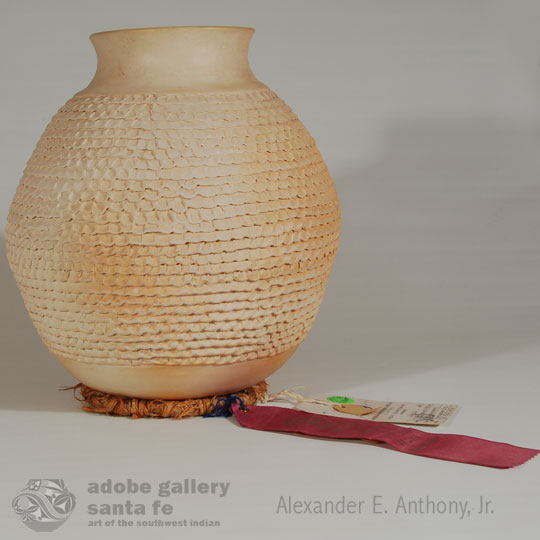 Hopi potter Polingaysi Qöyawayma, also known as Elizabeth White, studied ceramics under the tutelage of Charles Loloma, famous Hopi jeweler, who taught ceramic classes at the University of Arizona, Arizona State University and at the Institute of American Indian Arts in Santa Fe. Polingaysi was a teacher who began making pottery after she retired from that career in 1954. Once she learned the techniques, she began searching for a style that suited her taste and personality. When she found uniquely special clay that needed no painted design to bring out its beauty, she decided to use only the unadorned clay.
Hopi potter Polingaysi Qöyawayma, also known as Elizabeth White, studied ceramics under the tutelage of Charles Loloma, famous Hopi jeweler, who taught ceramic classes at the University of Arizona, Arizona State University and at the Institute of American Indian Arts in Santa Fe. Polingaysi was a teacher who began making pottery after she retired from that career in 1954. Once she learned the techniques, she began searching for a style that suited her taste and personality. When she found uniquely special clay that needed no painted design to bring out its beauty, she decided to use only the unadorned clay.
Hopi Pueblo Hairknot Clown Katsina Doll by Ronald Honyouti - C3383N
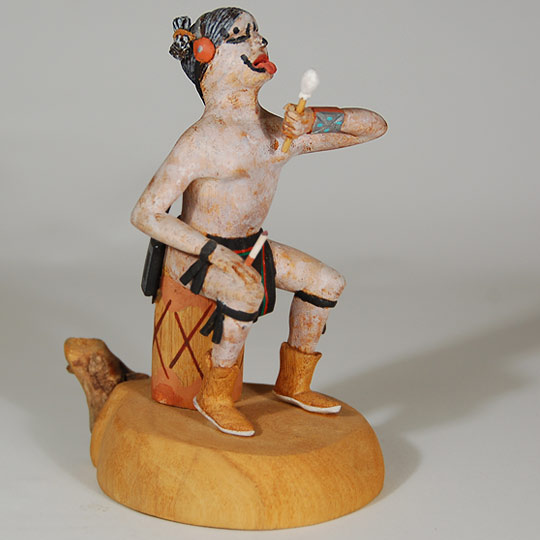 There is a group of Hopi Clowns named Tsutskutu. Some of them have yellow body paint and are known as Sikya Tsuku and others have white body paint and are known as O-oto Tsuku. The Na'somta Tsutsukutu clown illustrated here by Ronald Honyouti is one of the O-oto Tsuku clowns. Their name derives from the manner in which they have their hair tied in a knot.
There is a group of Hopi Clowns named Tsutskutu. Some of them have yellow body paint and are known as Sikya Tsuku and others have white body paint and are known as O-oto Tsuku. The Na'somta Tsutsukutu clown illustrated here by Ronald Honyouti is one of the O-oto Tsuku clowns. Their name derives from the manner in which they have their hair tied in a knot.
Would you like to buy or read more?
#adobegallery #HopiPueblo #Katsina #Kachina # #Doll #SouthwestIndianArt #PuebloArt #SantaFeNM #RonaldHonyouti
Original Taos Pueblo Painting “The White Horse” by Juan W. Mirabal - C3514.10
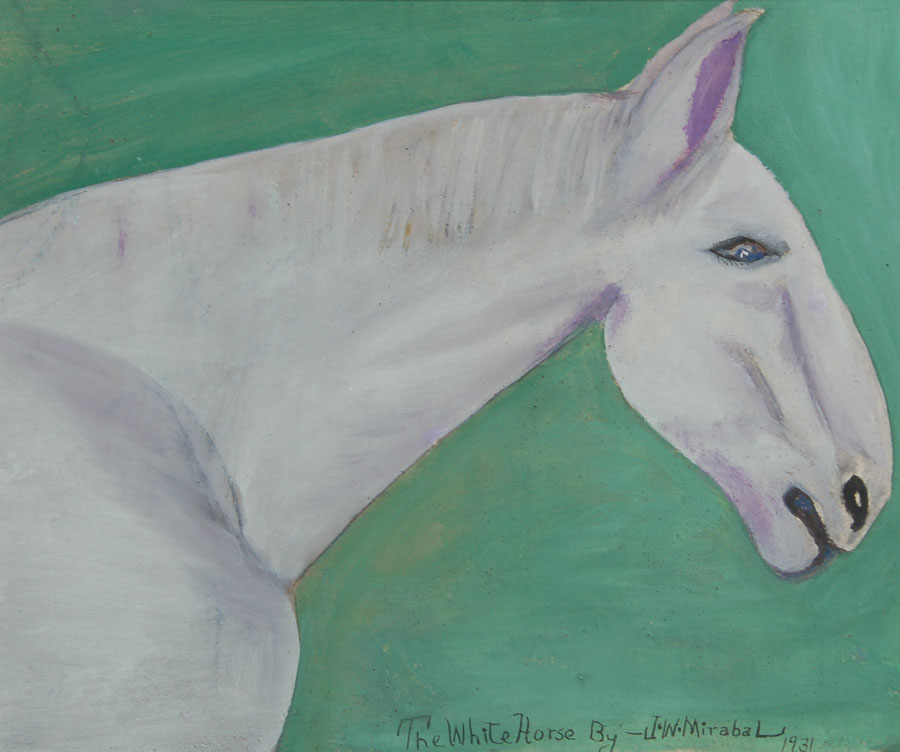 Juan Mirabal, an artist from Taos Pueblo, was joined by two other Taos Pueblo artists, Albert Lujan and Albert Looking Elk, in painting in a realistic three-dimensional Euro-American style in the 1915 to 1920 period. Lujan and Looking Elk mostly painted scenes of Taos Pueblo buildings and surroundings and sold their art directly to tourists visiting the pueblo. Because they did not paint in the flat style other Natives were producing, their work was considered "not Indian."
Juan Mirabal, an artist from Taos Pueblo, was joined by two other Taos Pueblo artists, Albert Lujan and Albert Looking Elk, in painting in a realistic three-dimensional Euro-American style in the 1915 to 1920 period. Lujan and Looking Elk mostly painted scenes of Taos Pueblo buildings and surroundings and sold their art directly to tourists visiting the pueblo. Because they did not paint in the flat style other Natives were producing, their work was considered "not Indian."
Small Historic Hopi Pueblo Polychrome Jar - C3901C
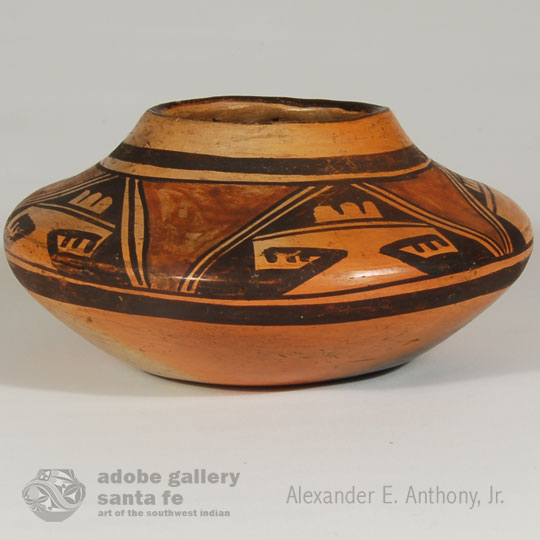 Large pottery vessels always elicit favorable comments and admiration because of their scale. Equally, small vessels receive favorable comments because of their diminutive scale.
Large pottery vessels always elicit favorable comments and admiration because of their scale. Equally, small vessels receive favorable comments because of their diminutive scale.
This small Hopi vessel contains all the magnificence of its larger brethren. It has a rounded bottom that expands outward to mid-body, then upward and inward-sloping to a short, raised neck. The design is restricted to the upper shoulder and is framed on its upper and lower ends with wide framing lines. The five red triangles evoke a feeling of a star when viewed looking down from the top.
Would you like to buy or read more about this pottery?
San Ildefonso Pueblo Black Pottery Jar by Maria and Santana Martinez - C3901E
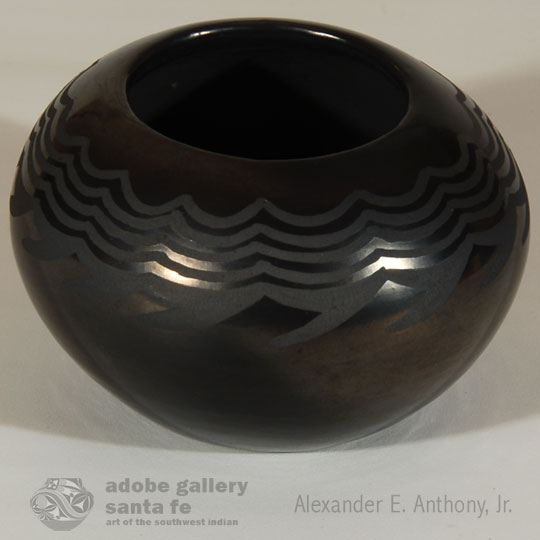 Following Julian's death in 1943, Santana, wife of Maria's oldest son, Adam, began assisting Maria with her pottery. Maria still formed and finished the pottery and Santana's contribution was decorating it. There are two periods that were collaborated by Maria and Santana. The earlier ones were signed Marie & Santana and that period lasted from Julian's death in 1943 until 1956, at which time Popovi Da replaced Santana and helped his mom. Maria did not immediately stop working with Santana when she began working with Popovi but continued periodically for a few more years. Those pieces are signed Maria & Santana.
Following Julian's death in 1943, Santana, wife of Maria's oldest son, Adam, began assisting Maria with her pottery. Maria still formed and finished the pottery and Santana's contribution was decorating it. There are two periods that were collaborated by Maria and Santana. The earlier ones were signed Marie & Santana and that period lasted from Julian's death in 1943 until 1956, at which time Popovi Da replaced Santana and helped his mom. Maria did not immediately stop working with Santana when she began working with Popovi but continued periodically for a few more years. Those pieces are signed Maria & Santana.
Acoma Pueblo Fine Line Faceted Design Jar by Marie Zieu Chino - C3901B
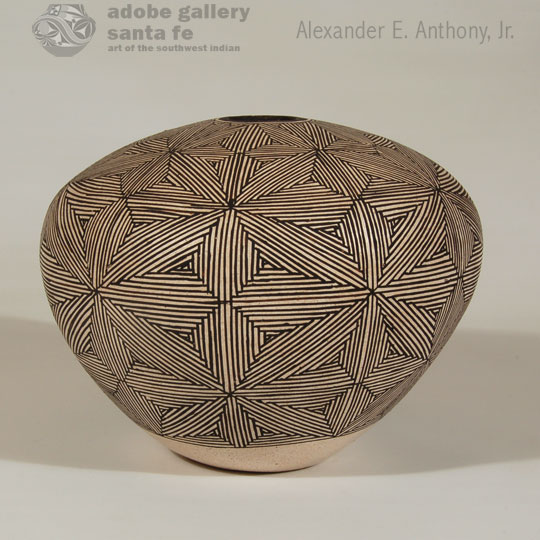 Marie Zieu Chino (1907-1982) is considered one of the significant ceramicists at Acoma and was the matriarch of a very talented family of potters. She is best known for her black-on-white pottery. Along with Lucy Lewis and Sarah Garcia she led the revival of ancient pottery forms of the ancestral pueblo potters. She was one of the women who was inspirational in the movement to revive the use of ancient Mimbres designs on contemporary Acoma pottery.
Marie Zieu Chino (1907-1982) is considered one of the significant ceramicists at Acoma and was the matriarch of a very talented family of potters. She is best known for her black-on-white pottery. Along with Lucy Lewis and Sarah Garcia she led the revival of ancient pottery forms of the ancestral pueblo potters. She was one of the women who was inspirational in the movement to revive the use of ancient Mimbres designs on contemporary Acoma pottery.
Chino was a master potter and it is understandable why collectors admire her work so enthusiastically. She was certainly one of the Acoma potters who made particularly important contributions to the art of pottery making in the period following World War II. She had been making pottery since 1920. She won her first award at Indian Market when she was only 15 years old. Some of her pieces were among the prizewinners at the first Southwest Indian Fair (predecessor to Santa Fe's Indian Market) in 1922.
Would you like to buy or read more?
Laguna Pueblo Heart of the Dragonfly Earrings by Greg Lewis - C3902A
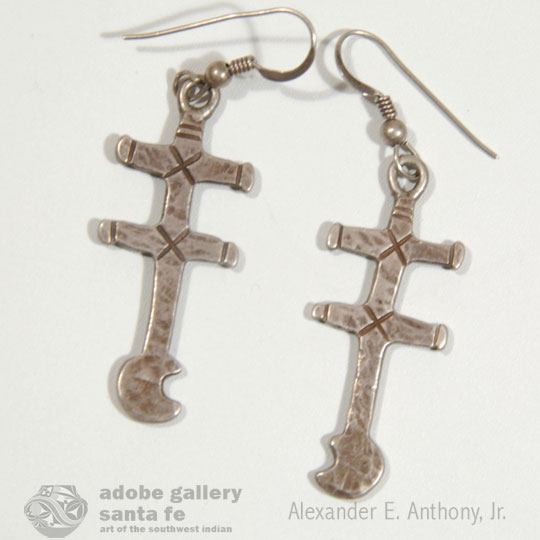 Silver double-bar crosses are frequently referred to as "dragonfly crosses." The dragonfly image was used by the Ancestral Pueblos long before the arrival of the Spanish. Early Spanish priests attributed the use of the cross to a miraculous encounter of the early Pueblos with the Holy Spirit.
Silver double-bar crosses are frequently referred to as "dragonfly crosses." The dragonfly image was used by the Ancestral Pueblos long before the arrival of the Spanish. Early Spanish priests attributed the use of the cross to a miraculous encounter of the early Pueblos with the Holy Spirit.
Zuni Pueblo Heheya Katsina Doll, circa 1950s - C3535.49
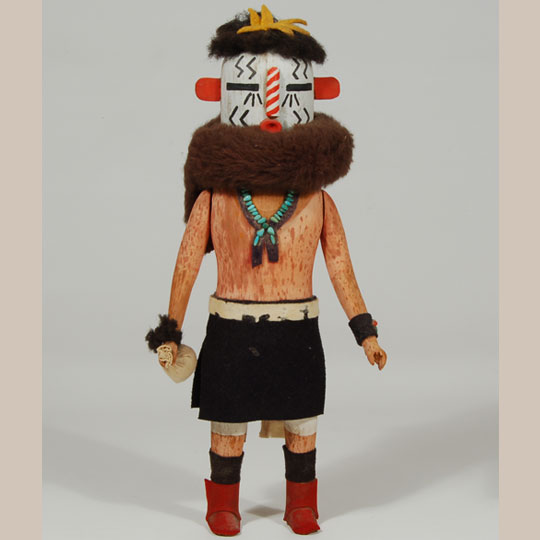 As is tradition, this Zuni Pueblo Katsina doll was carved from a single piece of wood for the complete body, with the arms and ears separately applied. Also, in traditional Zuni form, each arm of the doll has been attached with a peg so that it articulates, and the skirt and moccasins have been made of fabric.
As is tradition, this Zuni Pueblo Katsina doll was carved from a single piece of wood for the complete body, with the arms and ears separately applied. Also, in traditional Zuni form, each arm of the doll has been attached with a peg so that it articulates, and the skirt and moccasins have been made of fabric.
Cochiti Pueblo Medium Size Drum Painted Blue - 25509
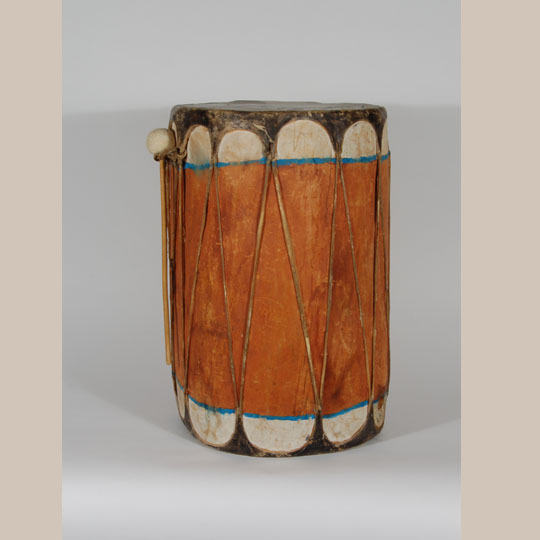 The Cochiti Pueblo Medium Size Drum Painted Blue is painted blue and the ends near the drum heads are painted white with a red line separating the blue from the white. The edges of the drum heads are painted black and the heads are left in the natural color of the rawhide.
The Cochiti Pueblo Medium Size Drum Painted Blue is painted blue and the ends near the drum heads are painted white with a red line separating the blue from the white. The edges of the drum heads are painted black and the heads are left in the natural color of the rawhide.
Cochiti Pueblo Painted Drum - 15868
 The Spaniards introduced the two-headed drum used by the Pueblo Indians of New Mexico over 400 years ago. It is not known if there was an earlier native type of clay or wood drum previous to this. The drum is used for ceremonies, rarely for other purposes.
The Spaniards introduced the two-headed drum used by the Pueblo Indians of New Mexico over 400 years ago. It is not known if there was an earlier native type of clay or wood drum previous to this. The drum is used for ceremonies, rarely for other purposes.
The two-headed pueblo drum is made from a fallen cottonwood or aspen trunk; a section is cut and hollowed out with a knife, and both ends are then covered with skin. Skins are cut in a circle with a scalloped edge, soaked overnight, and then secured to the hollowed log. Points of the scallop are pierced with an awl, laced together, and a loop handle of rawhide or thongs is attached on one side. It is traditional to then partially paint the drum.
Would you like to buy or read more?
Original San Ildefonso Painting of a Basket Dance by Encarnacion Peña - C3899C
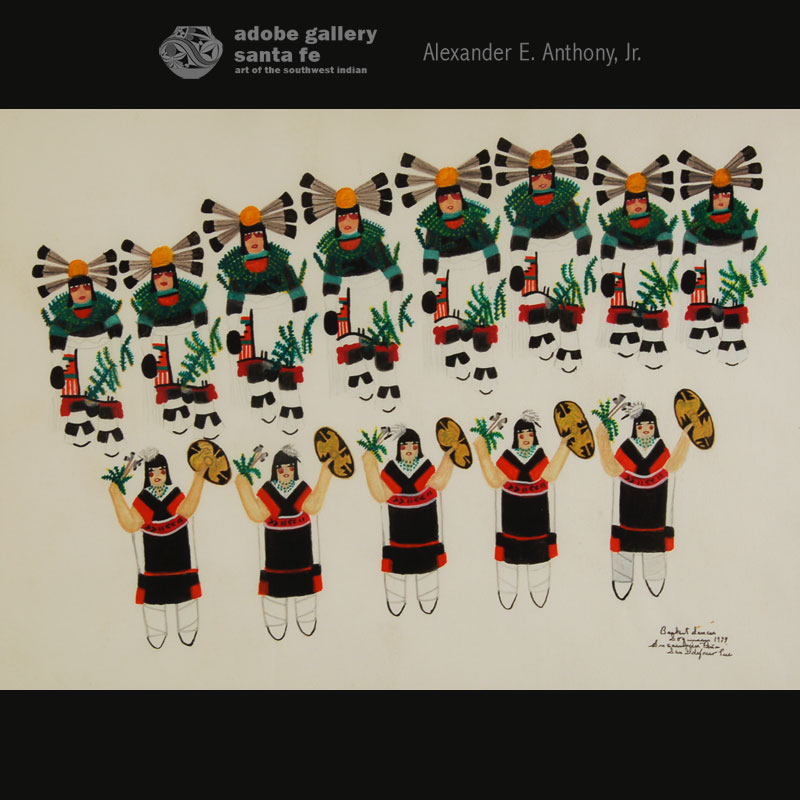 José Encarnacion Peña (1902-1979) Soqween - So Kwa A Weh (Frost on the Mountain) was a student of Dorothy Dunn at The Studio of the Santa Fe Indian School in the early 1930s. He had, however, started painting earlier, as early as the 1920s, and continued until his death in 1979. His complete name was José Encarnación Peña and his Tewa name was spelled Soqueen, Soqween, So Kwa a Weh, translated to Frost on the Mountain. Those who remember him in his later years recall that he was called Enky (pronounced "inky").
José Encarnacion Peña (1902-1979) Soqween - So Kwa A Weh (Frost on the Mountain) was a student of Dorothy Dunn at The Studio of the Santa Fe Indian School in the early 1930s. He had, however, started painting earlier, as early as the 1920s, and continued until his death in 1979. His complete name was José Encarnación Peña and his Tewa name was spelled Soqueen, Soqween, So Kwa a Weh, translated to Frost on the Mountain. Those who remember him in his later years recall that he was called Enky (pronounced "inky").
Peña was painting at San Ildefonso at the same time as Tonita Peña, Ricardo Martinez, Luís Gonzales, Abel Sánchez, and Romando Vigil. He was not very productive in the early years but became so about ten years before he passed away. He is represented in the collections of the Laboratory of Anthropology, Santa Fe; Museum of New Mexico; Denver Art Museum; and many others.
Would you like to buy or read more?
Small San Ildefonso Painting of a Single Male Dancer by Encarnacion Peña - C3899E
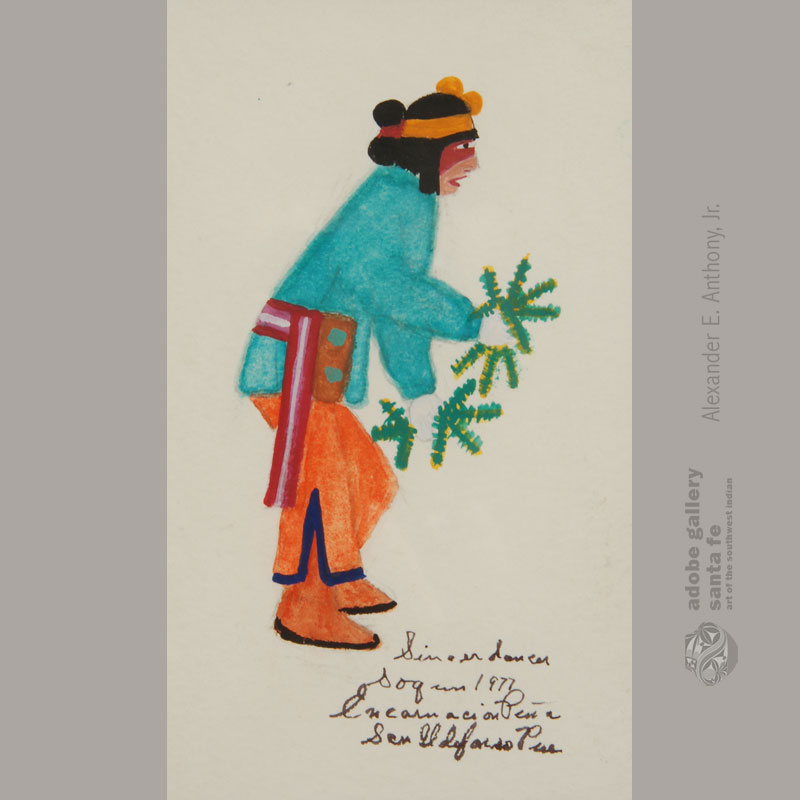 There were several artists painting at San Ildefonso Pueblo in the 1920s. Among them were Tonita Peña, Ricardo Martinez, Luís Gonzales, Abel Sánchez, Romando Vigil and Encarnación Peña.
There were several artists painting at San Ildefonso Pueblo in the 1920s. Among them were Tonita Peña, Ricardo Martinez, Luís Gonzales, Abel Sánchez, Romando Vigil and Encarnación Peña.
A little-known San Ildefonso artist is Encarnación Peña. One of the early artists, he produced little through the years. Like so many others, he was greatly influenced by the more outstanding men of his village, particularly in delicacy of style in painting dancers. Typical of so much pueblo work, the figures dominate the otherwise blank paper. Typically pueblo in style is the raised foot of the dancer, as if in motion.
Navajo Screw Post Earrings with Blue Gem Turquoise - C3902B
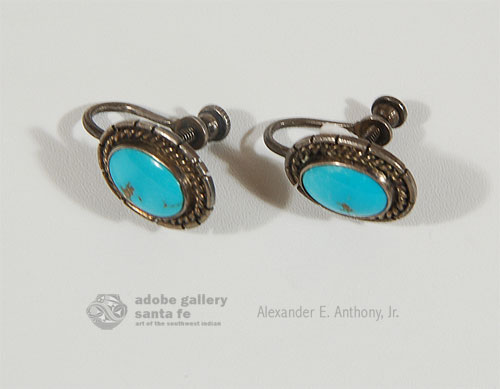 Blue Gem turquoise was used to make jewelry predominately in the 1940s and 1950s. The stunning sky blue color, when contrasted against a sterling silver background, became a symbol of Southwestern jewelry.
Blue Gem turquoise was used to make jewelry predominately in the 1940s and 1950s. The stunning sky blue color, when contrasted against a sterling silver background, became a symbol of Southwestern jewelry.
These delicate, finely-made earrings are an excellent example of jewelry made with Blue Gem turquoise. They are screw-back for the person who does not want pierced earrings.
Would like to buy or read more?
Polished Black San Ildefonso Pueblo Jar by Anita Martinez - 25961
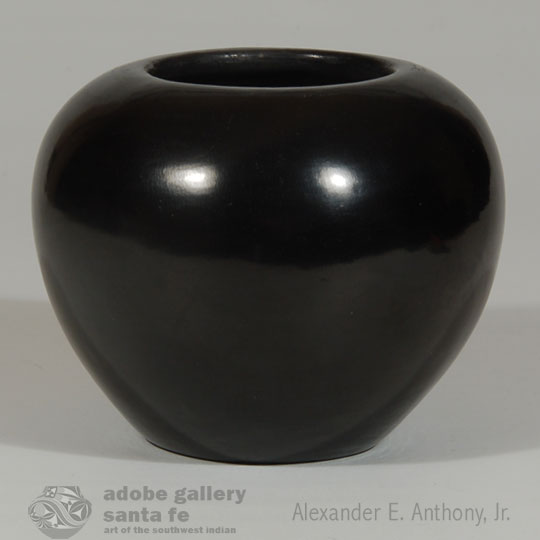 Anita Martinez was a daughter of Adam and Santana Martinez. She, too, was a potter and a very good one. She made quite a variety of shapes of pottery and often put lids on her small jars, such as this one. Because there are some abrasions around the rim, it is highly suspected that this jar had a lid in the past and does not have it now.
Anita Martinez was a daughter of Adam and Santana Martinez. She, too, was a potter and a very good one. She made quite a variety of shapes of pottery and often put lids on her small jars, such as this one. Because there are some abrasions around the rim, it is highly suspected that this jar had a lid in the past and does not have it now.
Kewa (Santo Domingo) Pueblo Chile Serving Deep Bowl - C3885C
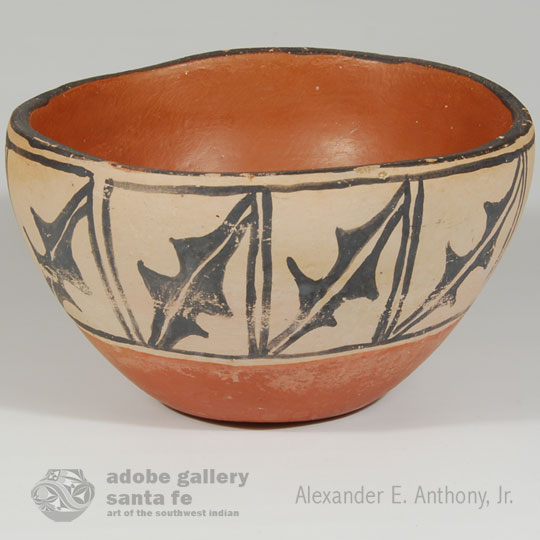 This Kewa Pueblo chile bowl is charming in its primitive appearance. It tilts slightly, the rim undulates, and the exterior paint is slightly abraded, yet, it is functional and appealing.
This Kewa Pueblo chile bowl is charming in its primitive appearance. It tilts slightly, the rim undulates, and the exterior paint is slightly abraded, yet, it is functional and appealing.
San Ildefonso Pueblo Painting of Deer Dancers and Deer Father by Gilbert Atencio - C3897B
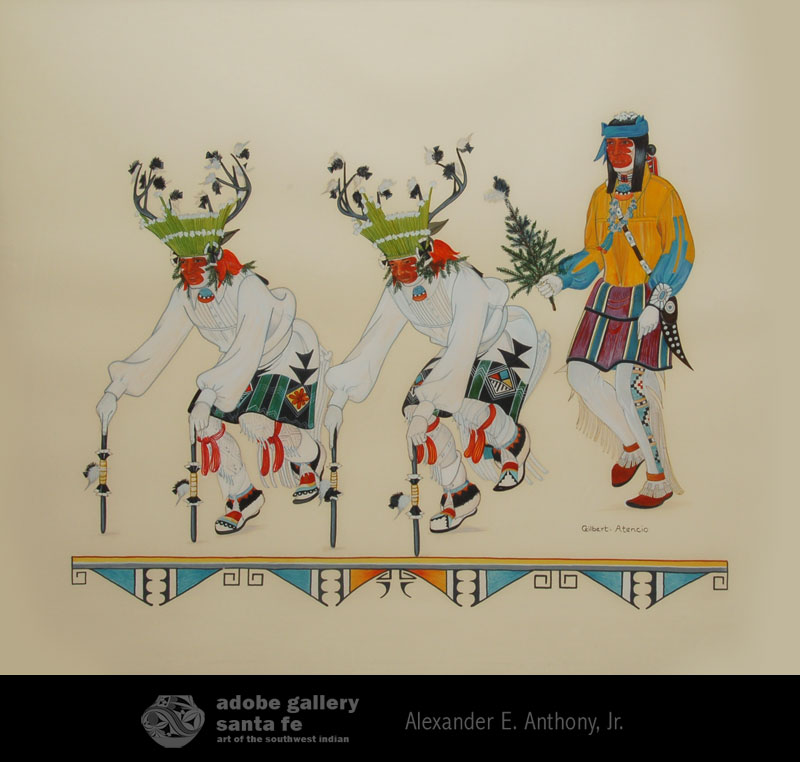 Richard M. Spivey and Gilbert Atencio became close friends during the years that Spivey was researching and writing the lives of Maria Martinez and her family. Gilbert's family included four siblings, one of whom was well-known Santa Clara Pueblo potter Helen Gutierrez. His parents were Isabel Montoya (1899-1996) and Benjamin Atencio (? -1963). His grandmother and Maria Martinez's mother were sisters, making him Maria's nephew. His niece is Geraldine Gutierrez, who is a painter and potter living at Santa Clara Pueblo.
Richard M. Spivey and Gilbert Atencio became close friends during the years that Spivey was researching and writing the lives of Maria Martinez and her family. Gilbert's family included four siblings, one of whom was well-known Santa Clara Pueblo potter Helen Gutierrez. His parents were Isabel Montoya (1899-1996) and Benjamin Atencio (? -1963). His grandmother and Maria Martinez's mother were sisters, making him Maria's nephew. His niece is Geraldine Gutierrez, who is a painter and potter living at Santa Clara Pueblo.
This Painting of Deer Dancers and Deer Father was a Christmas gift from Gilbert Atencio to Richard and Lynne Spivey in 1973. It is a ceremonial dance of Deer Dancers and the Deer Father, a dance presented in fall and wintertime.
Would you like to purchase or read more?

